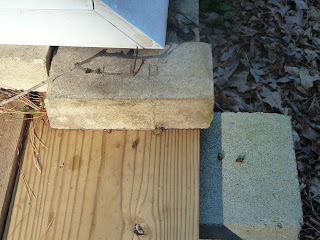
We've had a few warm days but the cold nights are here so it was time to put the final touches on the hives. This needed to be done when daytime temperatures were still tolerable for exposing the inside of the hives and as last weekend was in the high 60s-it was perfect. The feeders have been off for a couple of weeks, as I discussed in the September blog and now was the time to add the homasote. This is a compressed cardboard square that will absorb excess moisture and actually acts as a sponge. By the Spring, there will be water stains on it as it soaks up the dangerous humidity.

The homasote square has push pins on the bottom to raise it above the inner cover and the space that you see, will allow for air flow. Also the space allows the girls to walk around under there and get outside if the weather permits (the outer cover has a gap that they'll use as an escape hatch).
I've discussed earlier that bees are an amazingly resilient insect and that their focus is always the survival of the colony. In the fall, this is manifested by their culling their numbers in preparation for the winter and restricted food source. The drones are useless in the winter-they don't keep the hive clean, maintain the temperature of the colony, or forage on warmer days. Because of that, they are, shall we say "voted off the island". Actually, they're executed
and the hive entrance is littered with their bodies.
It's kind of a bizarre thing to see the first time but it's nature's way of survival.
There's nothing left to do now but to check back in January and see if the bees have enough stored honey left to eat or if they need it supplemented. Some people wrap their hives in December to prevent winter winds from threatening the inner temperatures and some beekeepers strongly advise against it. I was given a hive wrap and may decide to wrap the one most exposed to the elements and not the other but will wait and see how severe the winter seems.

